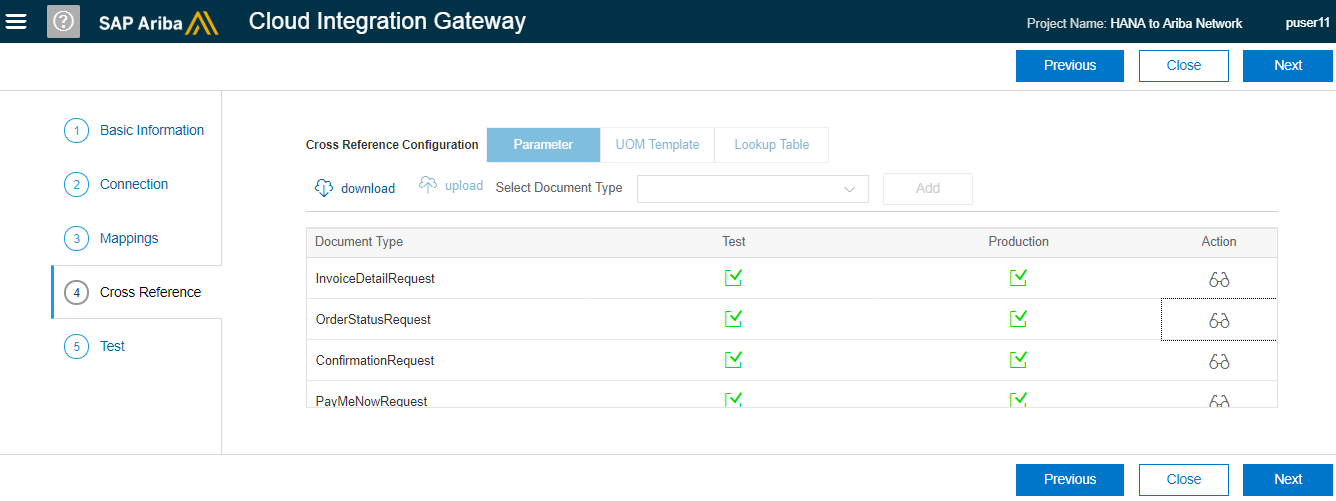SAP Cloud Integration Gateway (CIG) for Ariba
Procurement Landscape Transformation options from SAP has "Integration Strategy" as one of the important landscape decision to make.
Sample answers for landscape transformation from SAP ECC/ SAP SRM to SAP Ariba are given below:
 Table 1: Landscape Transformation Options for SAP Customers
Table 1: Landscape Transformation Options for SAP Customers
To make life easier for Ariba customers, SAP recommends use of "SAP Cloud Integration Gateway" as a future integration strategy. This strategy of integration is recommended due to following benefits:
- Simplicity: A single gateway with prepackaged mapping content to make integrations fast and painless, eradicating the effort and expense of one-off, adapter-based integrations.
- Self-service: Intuitive wizard-based setup and a user-friendly self-testing framework to guide through a streamlined three-step process that lets you configure, extend, and test transactions
on your own.
- Speed: Automated processes eliminate lengthy deployments and manual testing, enabling you to complete integration in a fraction of the time formerly required (50% implementation time saved) – and make stakeholders happy with go-lives that happen in weeks, not months.
CIG is new tool for Buyer side integration but it is in use for Ariba network supplier side integrations since year 2016. Our focus in this blog is the new CIG Buyer side integration (i.e integration between Ariba solutions and S/4 HANA)
CIG is good news for everyone, For customers, there is no subscription fee hence better ROI (Return On Investment) on Ariba implementation.
For consultants, no need to have technical integration experience (like you need in case of SAP PI/PO) to implement this product.
Objective of this blog is to introduce SAP Ariba consultants, Integration consultants and prospective customers to CIG in simplistic but in detailed manner.
This blog is structured into three sections: Understand, Learn and Implement.
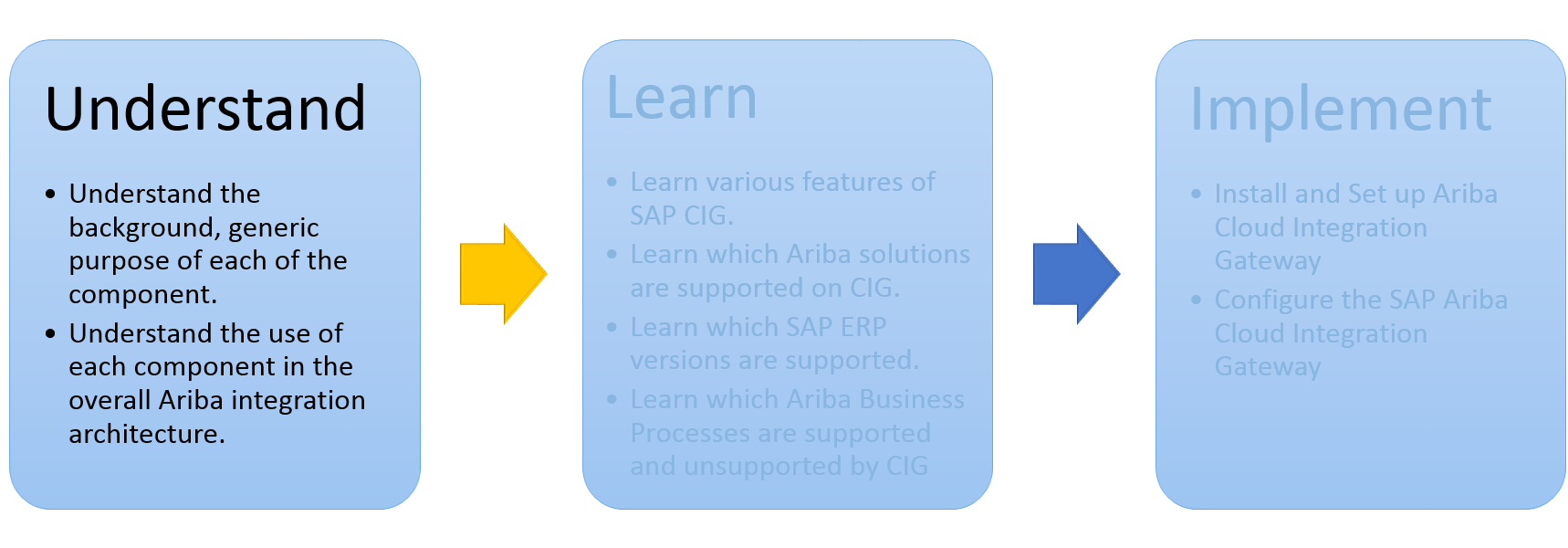
Understand Ariba Integration Architecture with CIG
To understand the overall Ariba integration architecture with CIG we need to understand various components involved. Note that the enablement components are shown as dotted lines for better understanding.
 Figure 1: Understand Ariba Integration Architecture with CIG
Figure 1: Understand Ariba Integration Architecture with CIG
Thus we will have to understand the various concepts in following order:
- SAP Cloud Platform (SCP)
- SAP Cloud Platform Integration (CPI) service
- SAP Connectivity Service
- SAP Cloud Connector
- CIG add-on for SAP ERP/ S/4 HANA
- SAP Cloud Integration Gateway (CIG)
Observation: There is no Ariba ITK (Integration Toolkit) in the architecture as the capability is in-built in CIG and CIG add-on.
Note: Ensure that you get comfortable with Abbreviations SCP, CPI, CIG at this stage of the blog to avoid potential confusion as you read through.
1. Understand SAP Cloud Platform (SCP) with context to CIG
The first of the many steps taken by SAP to make integration easier between on-cloud solutions and on-premise solutions was way back in year 2012 when SAP launched the idea of SAP Cloud Platform (SCP).
Key purpose of SCP as in the diagram below are:
- Build New Cloud Apps
- Extend On-Premise & Cloud Apps
- Integrate everything
In this blog we are interested in integrate everything (Solutions, Things, Data etc.) offering of the SCP.
 Figure 2: SAP Cloud Platform (Platform as a Service)
Figure 2: SAP Cloud Platform (Platform as a Service)
Developers can develop extensions on SAP Cloud Platform and then connect these new extension apps to the core solution via API available. Thus the Cloud platform have to have API and as big picture the integration service to enable the integration with other solutions.
 Figure 3: Use of SAP Cloud Platform for developing Ariba extension applications
Figure 3: Use of SAP Cloud Platform for developing Ariba extension applications
This integration service is called "SAP Cloud Platform Integration" (CPI). In the diagram below, you can see On-premise managed cloud solution like S/4 HANA on the left hand side and Public Cloud solution Ariba is on the right hand side. These both solutions are integrated using the platform integration service.
 Figure 4: Integrate everything or integration service of SCP
Figure 4: Integrate everything or integration service of SCP
Lets have closer look at it in next section.
2. Understand SAP Cloud Platform Integration (CPI) Service in context to Ariba
SAP CPI service is available via https://api.sap.com and is hosted on SAP Cloud Platform. This service can be used to integrate any on-premise or third party systems with the cloud solutions from SAP.

Figure 5: SAP Cloud Platform Integration (CPI) capabilities
Following are the features of SAP CPI which will benefit Ariba Customers in long term.
Pre-packaged integration flows: One can explore the content made available though simple URL. Integration packages contain integration flows, value mappings, templates, and OData services. API packages contain APIs and policy templates
Multi-Level security: As this is cloud platform the security is taken much more seriously by SAP with offering like payload encryption, own tenants for customers, customer data in database is separated via different schema for each customer and customer can encrypt their data with own key before persisting data to SAP Cloud Platform.
SAP CPI provides various integration packages for SAP Ariba solutions:
- Integration of Ariba Network with SAP Business Suite (#2 integration flows)
- SAP ERP and SAP S/4HANA Integration with SAP Ariba solutions (#6 integration flows)
- SAP Ariba APIs (#21 APIs)
Figure 6: SAP Cloud Platform Integration: Ariba Content PackagesLet's look at how detailed the content is in the second package shown above (SAP ERP and SAP S/4 HANA Integration with SAP Ariba solutions)Figure 7: Sample content overview of integration package for Ariba solutions
All the above Ariba prepackaged mapping content will be displayed in the Cloud Integration Gateway as soon as you enable it on your Ariba Realm.Harmonized web services does not need any mapping hence web services between SAP Ariba and S/4 HANA does not need any mapping in standard fields. Thus one major task done without any efforts and time spent. Still if you want to see the integration flow you can visit the packages for Ariba on SAP CPI.
3. SAP Connectivity Service
SAP Cloud platform connectivity service is used to establish connections between cloud applications and on-premise systems.
- Access HTTP, RFC and TCP protocols for cloud to on-premise communication and JDBC/ODBC for communication with cloud databases.
- For your cloud applications, you can use LDAP-based user management if you are operating an LDAP server within your network.
- Use an identity provider to simplify the access of SAP Cloud Platform users to on-premise systems. For this purpose, you can configure a trusted relationship in the Cloud Connector to support principal propagation.

Figure 8: SAP Cloud Platform: Connectivity Service capability
You can see that Cloud connector is the main software that needs to be installed in the firewall of the on-premise system to connect to the subaccount of the SAP Cloud Platform.
4. SAP Cloud Connector
There are two options to connect on-premise system to on cloud system.Option 1: Reverse Proxy Approach Figure 9: Connectivity option using reverse proxy
Figure 9: Connectivity option using reverse proxy
- Pros: Existing network infrastructure can be used
- Cons: Configuration of DMZ and firewall needed, attacks from internet possible, not all protocols supported.
Option 2: SAP Cloud Connector as on-premise agent

Figure 10: Connectivity option using Cloud Connector
- Pros: On-premise agent not reachable from internet, easy set up and configuration
- Cons:additional on-premise component
Thus due to its minimal configurations, high security and support for multiple protocols, it is recommended to use cloud connector for connecting Ariba to SAP ERP/ S/4 HANA on premise.
5. Understand CIG Add-on
There are two CIG add-on, one for SAP ERP and other for SAP S/4 HANA. These can be downloaded by your SAP Basis consultants and can be installed using transaction/utility SAINT.
6. Understand SAP Cloud Integration Gateway
We know that having prepackaged content from SAP CPI is not enough, it has to be implemented to be of any real use. Ariba CIG is just that but with even better vision:
- Single Gateway to integrate SAP Cloud solutions to other cloud or on-premise solutions.
- Faster deployment
- Do-it-Yourself (DIY) integration with Automated testing
Thus SAP Ariba Cloud Integration Gateway is a simple and efficient way to integrate through one gateway to Ariba Network, SAP Ariba cloud applications, Non SAP Cloud solutions, Internet of Things and trading partners. Refer to the diagram below to understand the broader integration coverage of the Ariba CIG.

Figure 11: Ariba CIG overall capability
NOTE 1: The initial release of SAP Ariba Cloud Integration Gateway focuses on SAP ERP and SAP S/4 HANA integration. However, the SAP Ariba open adapter powered by Liaison Technologies and Dell Boomi is the recommended integration option for customers running on non-SAP ERP systems.
NOTE 2: There is no additional subscription fee for CIG for customers who have subscribed to SAP Ariba solutions.
Now its time to deep dive into Cloud Integration Gateway to know its features and compatibility.

Learn Cloud Integration Gateway (CIG)
To learn this new method of integration we will start with learning the features of this gateway followed by supported applications, supported business processes and lastly integration architecture withe CIG.
Features of CIG
Now we know that Ariba CIG is set of tools to make Ariba integration easier while these tools use many services from SAP CPI to work in harmony.

Figure 12: Ariba CIG complete features overview
Below is the table describing all the features of the CIG.
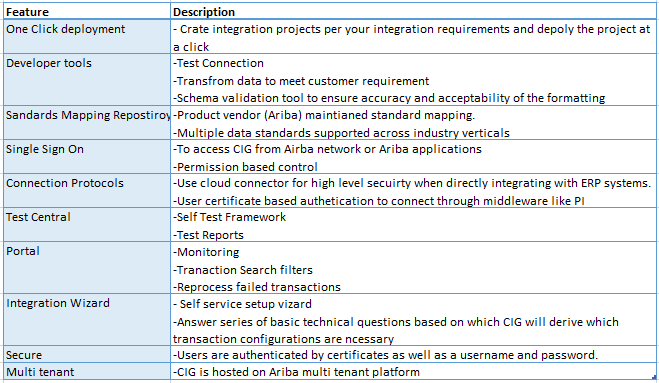
Refer to the features covered in CIG Overview Blog.
Supported Ariba Solutions
Ariba CIG right now supports most of the Ariba applications for buyer side integrations and Ariba network sell side integrations. Sell side integrations for applications like Supplier Life cycle & Performance (SL&P) and Spend Analytics are expected in the year 2019.
Refer table below for the Ariba applications supported by Ariba CIG.

Table 2: CIG supported Ariba Solutions
Supported SAP ERP Versions
Ariba CIG supports following SAP ERP versions.

Table 3: CIG Supported SAP ERP versions
Supported Business Processes
Ariba CIG supports most of the buy side as well as network based supplier side processes as listed below:

Table 4: CIG Supported Airba Business Processes
Ariba Integration Architecture with CIG
Let's have another look at the Ariba integration architecture without showing CPI as separate element for better understanding of the implementation as we move on to the next phase of learning CIG.
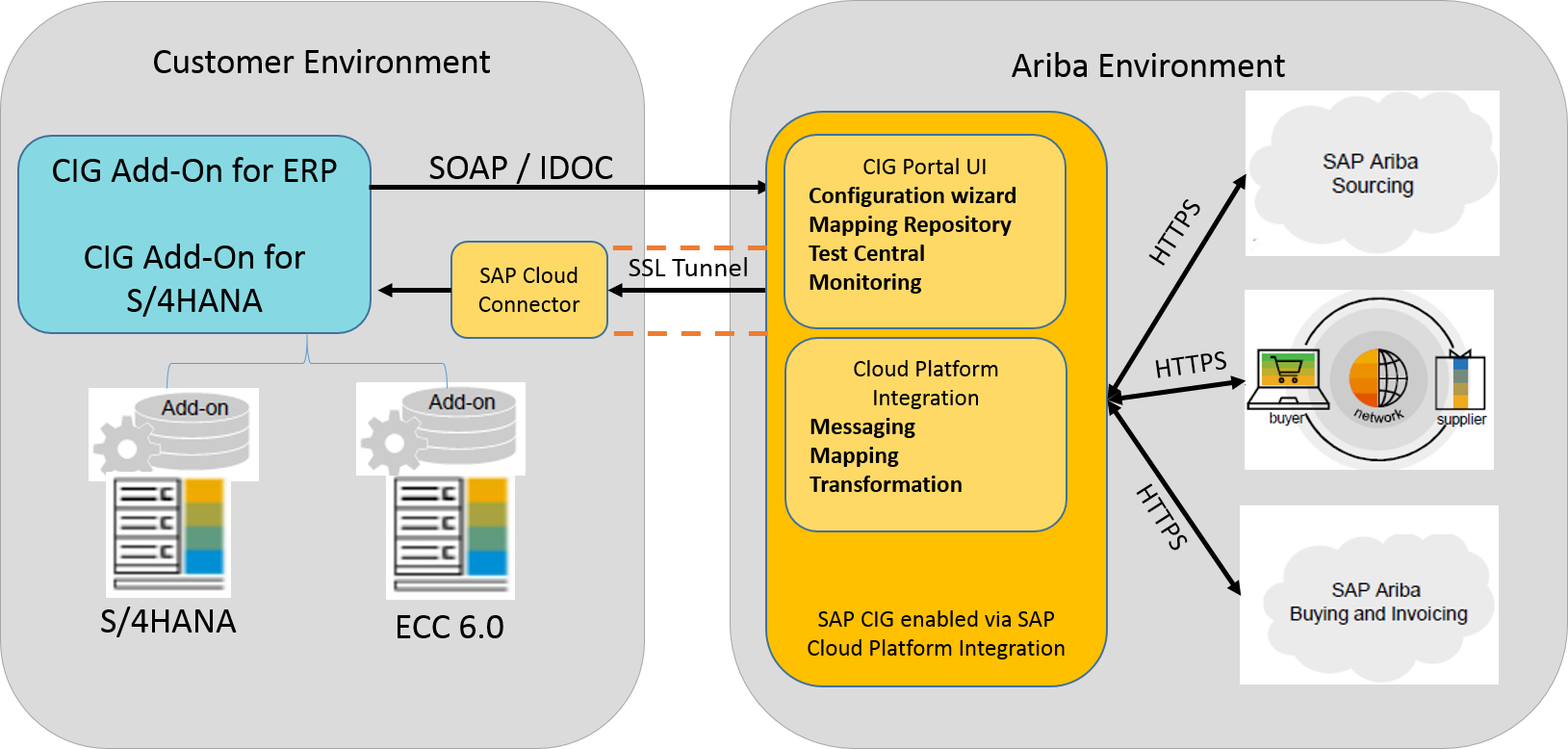
Figure 13: Ariba Integration Architecture with CIG (Revisited)
Lets move on to the next phase of implementation, where we will look at Ariba CIG generic implementation steps (not specific to particular Airba solution).

Implementation section is quite exhaustive and is categorized into three main areas: Configure, Extend and Test
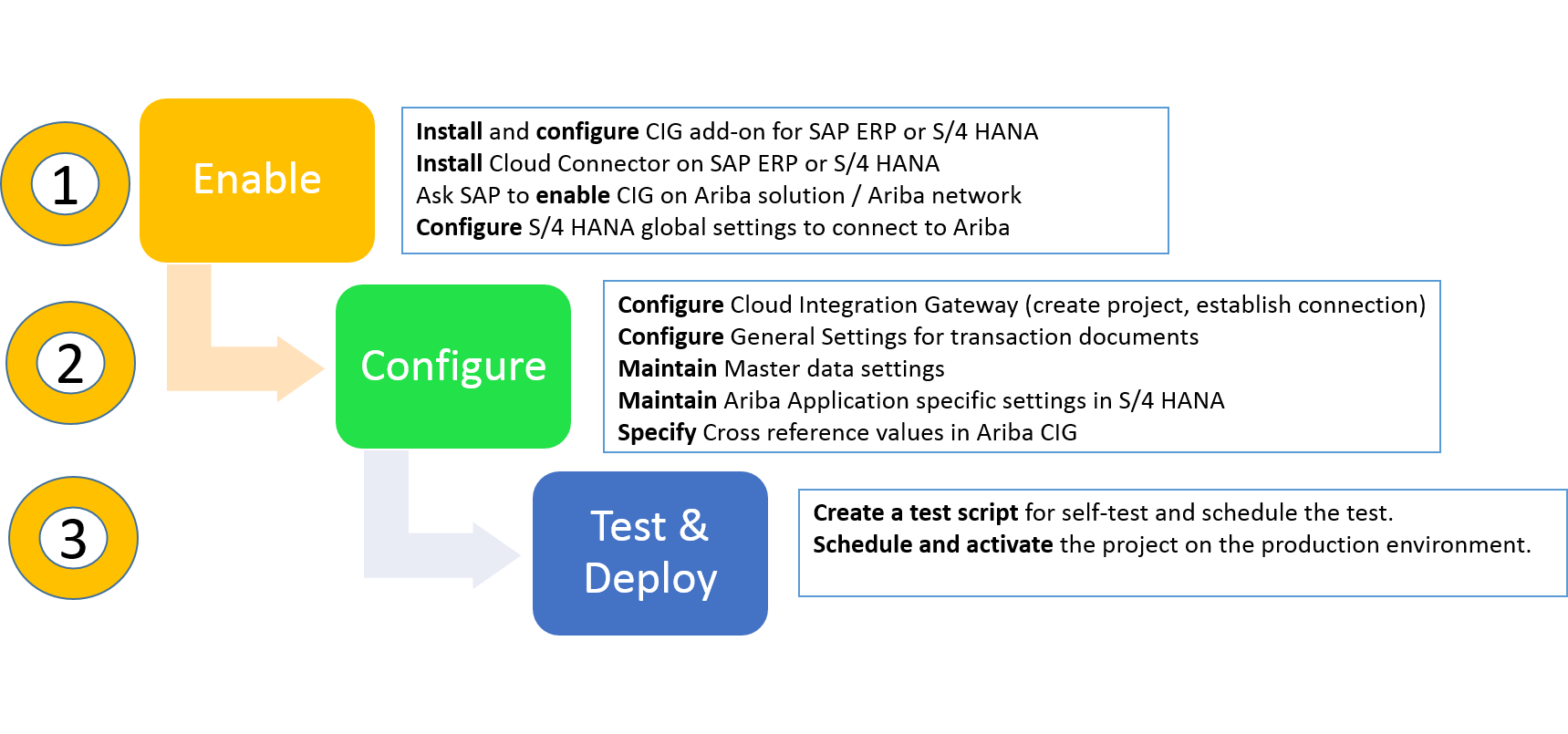
Implement Cloud Integration Gateway (CIG)
There are many configurations to be done on S/4 HANA and CIG hence summarizing the key configurations below
1 Enable
- Configurations to Enable Cloud Integration Gateway: Install S/4 HANA Add-on, install Cloud Connector, Ask SAP to enable CIG on Ariba solution, configure SAP ERP/ S/4 HANA global settings.
- Configure time, time zone settings and Formats in S/4 System.
1.1 Download and install SAP ERP add-on
From SAP ONE Support Launchpad choose add-on software for S/4 HANA:
- SAP Ariba Cloud Integration Gateway 1.0, add-on for SAP S/4HANA (ARBCI1 10S)
- Ariba Cloud Integration Gateway add-on S/4HANA
- Ariba Cloud Integration Gateway add-on S/4HANA for Retail
To install add-ons, see SAP Note 1841471. Once installed, check the status in your ERP system and you should see ARBCI1 & ARBCI2 components.

Figure 14: CIG Add-on installed
1.2 Set up the SAP Cloud Connector
I suggest you go through a detailed tutorial for SAP Cloud connector from Cloud Connector Tutorial while few key steps are shown below:
- Download the Cloud Connector installation archive (msi installer for windows) from SAP Development Tools for Eclipse.

Figure 15: Cloud connector download reference
- Install the Cloud Connector software as per the on screen instruction of installer. Once installed you can login to the screen shown below with your SAP Cloud Platform subaccount ID.
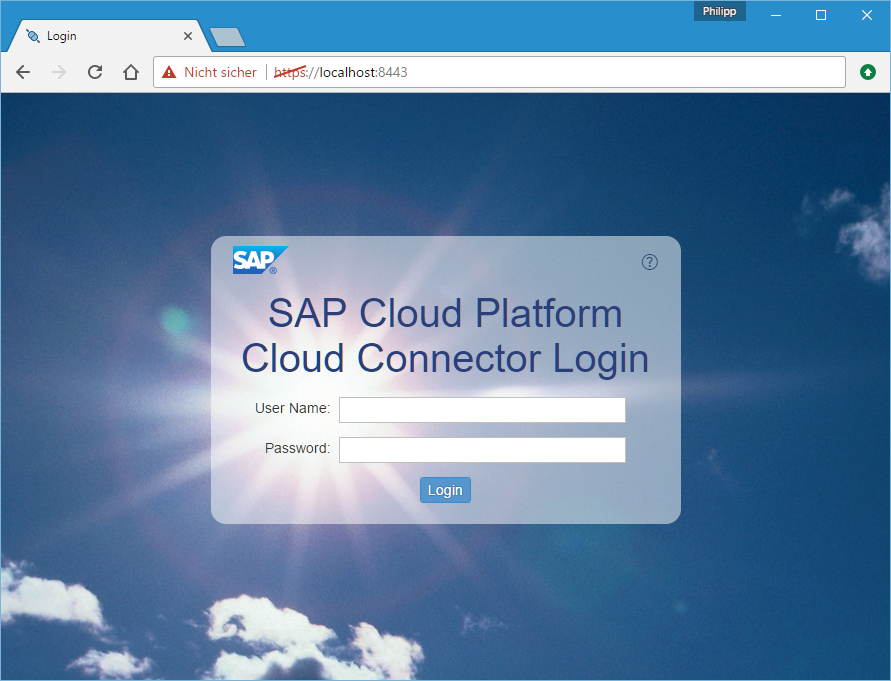
Figure 16: Cloud connector login
- Connect the cloud connector to SCP subaccount and test this connection

Figure 17: Cloud connector connected to SCP subaccount
- Connect the SCP subaccount to on-premise S/4 HANA and test this connection

Figure 18: SCP subaccount connection to S/4 HANA On-premise
1.3 Enable CIG on your Ariba Realm
Ask SAP customer support to enable Ariba CIG on your Ariba Realm. once enabled then you can see CIG from following path with respect to the Ariba Solution being used.
- If you are navigating from Ariba Network, use the following path: .
- If you are navigating from SAP Ariba Procurement / Strategic solutions, use the following path: .
Following is the navigation screen shot from Ariba Procurement solution:
 Figure 19: CIG enabled on Airba Buying solution
Figure 19: CIG enabled on Airba Buying solution
1.4 Set up the global settings to connect to the SAP Ariba Cloud Integration Gateway
Configure Global Settings (Maintain certificates, define RFC destination, and define port definition) in S/4 HANA system.
 Figure 20: Connection setting from S/4 HANA
Figure 20: Connection setting from S/4 HANA
Take help from your security expert to set up certificates for Single Sign On between Ariba, S/4 HANA and SCP subaccount.
1.5 Configure Time and Time Zone settings (Transaction STZBC in S/4 HANA system)
 Figure 21: Configure Time zones in S/4 HANA
Figure 21: Configure Time zones in S/4 HANA
2 Configure
- Configure the SAP Ariba Cloud Integration Gateway : Create Project, connect S/4 HANA
- Maintain Application Specific Settings: Maintain master Data settings, Maintain settings for Ariba solutions
2.1 Create and set up projects on SAP Ariba Cloud Integration Gateway.
i) Set up project with minimal description as shown below:
 Figure 22: Create New Project
Figure 22: Create New Project
ii) Complete Connection settings and test the connection to Ariba solution.
 Figure 23: Establish connection from CIG to S/4 HANA and Ariba
Figure 23: Establish connection from CIG to S/4 HANA and Ariba
2.2 Configure General Settings for transaction documents
2.2.1 Set up the interface
In S/4 HANA system go to Integration with Other SAP Components > SAP Ariba Cloud Integration Gateway > Ariba Network Integration > General Settings > Setup the Interface
 Figure 24: Configure interface setup from S/4 HANA to Airba Solutions
Figure 24: Configure interface setup from S/4 HANA to Airba Solutions
2.2.2 Document Status Update
Using the document status update, you can monitor status of all transaction that you send from your SAP ERP or
SAP S/4HANA system through
SAP Ariba Cloud Integration Gateway to suppliers on
Ariba Network and send the document status update for transactions that you receive, to suppliers on
Ariba Network.
i) Set up parameters for outbound documents as shown below:
 Figure 25: Set up document status update parameters
Figure 25: Set up document status update parameters
ii) Maintain Date-time to send Doc. Stat. Upd. for PayMeNow and Order Confirmation.
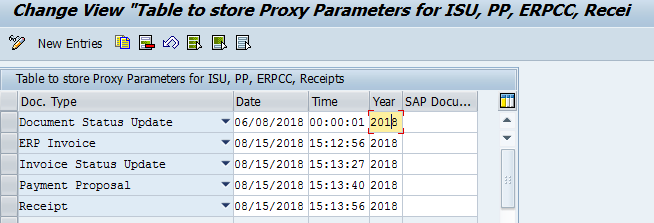 Figure 26: Set up document status update date and time
Figure 26: Set up document status update date and time
iii) Define Background job for for PayMeNow and order confirmation document status update.
Using transaction SM36 schedule program "ARBCIG_INBOUND_IDOC_SUR".
Once set up you can track status/failure of the job from SLG1 using object:
ARBCIG_UTILITY, and subobject;
DOCUMENTSTATUSUPDATE
iv) Enable vendors for Ariba Network
 Figure 27: Enable vendors for Ariba Network
Figure 27: Enable vendors for Ariba Network
2.3 Import Master Data
Note that AITK (Ariba Integration Toolkit) is no more required to transfer data between backend and SAP Ariba once CIG is configured for the same. Following are the summary of various configurations to be maintained for Master Data.
 Figure 28: Master Data general settings overview
Figure 28: Master Data general settings overview
2.3.1 Create your own directory on the SAP ERP system and give the Read and Write permissions to the directory e.g. C:\Ariba
2.3.2 Configure external commands for Operating system
 Figure 29: Configure external commands as per the configuration guide
Figure 29: Configure external commands as per the configuration guide
2.3.3 Configure Ariba Incremental Extract events
Ariba incremental events for CIG can be activated from this configuration.

 Figure 30: Configure incremental extraction events for master data
Figure 30: Configure incremental extraction events for master data
2.3.4 Ariba Event Linkages
Now that events are active its time to link them to trigger the events when needed.
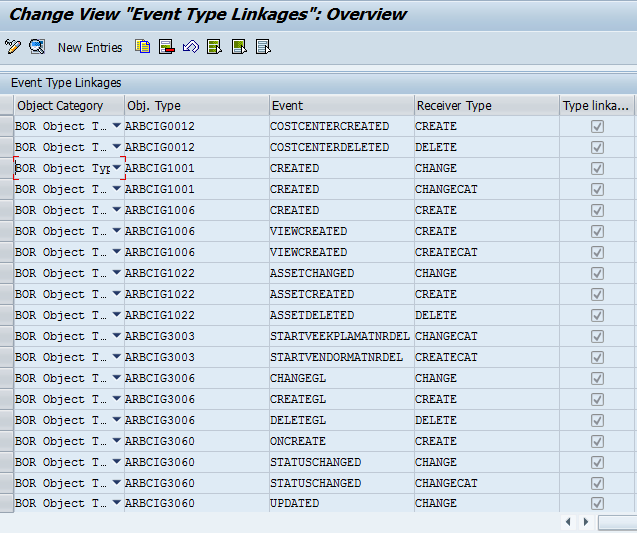 Figure 31: Activate Ariba Event Linkages for Master Data
Figure 31: Activate Ariba Event Linkages for Master Data
2.3.5 Maintain Date and Time stamp for Master Data
 Figure 32: Maintain date and time stamp for master data
Figure 32: Maintain date and time stamp for master data
2.3.6 User Profiles for Master Data
 Figure 33: Maintain user profile for master data
Figure 33: Maintain user profile for master data
2.3.7 Schedule Job for Master Data
Define background job schedule the program
"ARBCIG_MASTER_DATA_EXPORT"
NOTE: we have now looked at master data configuration steps which are common to all solutions. Suggest that you go through the configurations for individual solutions on your own.
2.4 Maintain Application Specific Settings
After master data integration it is time to focus on configuration for transaction data. As there are many Ariba solutions, let's focus on the Ariba network settings as part of this blog.
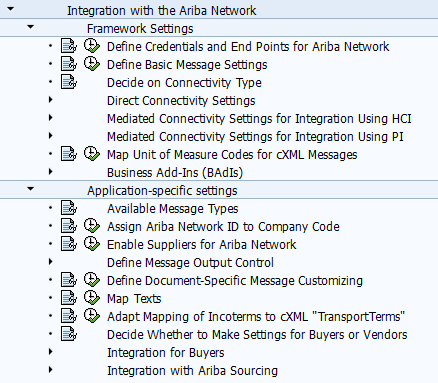 Figure 34: Application specific settings overview for Ariba Network
Figure 34: Application specific settings overview for Ariba Network
2.4.1: Define credentials and End Points of Ariba Network
If you have already maintained certificates then you need not assign credentials through following config. If you opt for it then note that
An Ariba Network ID can have multiple end points. An
end point is a document routing placeholder that ensures documents from Ariba Network are sent to the required destinations (system).
The
Ariba Network ID is displayed to suppliers on Ariba Network. You can have one or several IDs. For example, each company code or purchasing organization can have a separate ID. The Network ID is transferred with each outbound cXML message and identifies your company as the sender.
Ariba Network ID: mention you buyer Ariba network ID here
Shared Secret: Maintain shared secret for your above ID
Enable system ID: select as Enabled
System ID: Mention system ID of your backend
5.1.2: Define Basic Message Settings
In this customizing specify which cXML message types to be exchanged with the business network.
 Figure 35: Define basic messages for Ariba Network
Figure 35: Define basic messages for Ariba Network
5.1.3 Decide on connectivity
This is information for further configurations on connectivity.
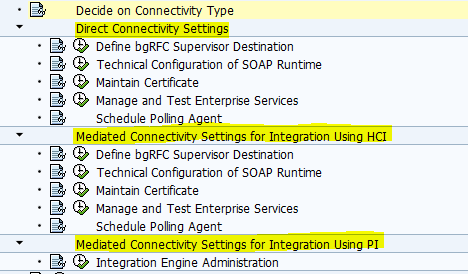 Figure 36: Define Connectivity Option
Figure 36: Define Connectivity Option
for example, we chose direct connectivity and hence following key configurations are discussed.
5.1.4 Define Background user and Supervisor destination.
Maintain user "BGRFCSUPER". Assign the
Authorization Role "SAP_BC_BGRFC_SUPERVISOR' in client "000" of S/4 HANA system.
Define RFC destination "BGRFC_SUPERVISOR" with above system user.
3 Test & Deploy
As you can see integration effort on CIG are minimal while SAP consultants still have to manage lot of configurations on S/4 HANA or SAP ERP side for tighter integration.
Happy reading and feel free to ask questions in reference to this blog will be happy to respond as much as possible.




 Figure 9: Connectivity option using reverse proxy
Figure 9: Connectivity option using reverse proxy








































